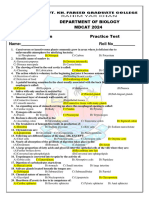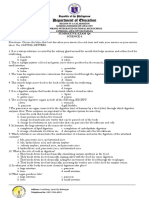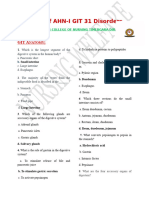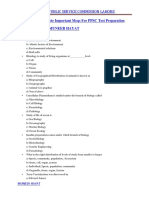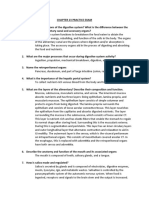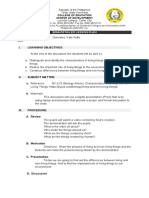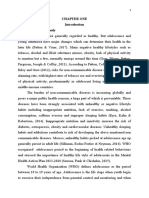0 ratings0% found this document useful (0 votes)
104 viewsDygestive System Question
Dygestive System Question
Uploaded by
rika siti syaadahThe document discusses the human digestive system. It covers topics like how food moves through the digestive tract via muscle contractions, where digestion takes place primarily in the small intestine, and the roles of the liver, stomach acid, and fiber in digestion. The document also addresses causes of issues like ulcers, food poisoning, and heartburn. It asks multiple choice questions to test understanding of the digestive process, organs involved, and their functions.
Copyright:
© All Rights Reserved
Available Formats
Download as DOCX, PDF, TXT or read online from Scribd
Dygestive System Question
Dygestive System Question
Uploaded by
rika siti syaadah0 ratings0% found this document useful (0 votes)
104 views6 pagesThe document discusses the human digestive system. It covers topics like how food moves through the digestive tract via muscle contractions, where digestion takes place primarily in the small intestine, and the roles of the liver, stomach acid, and fiber in digestion. The document also addresses causes of issues like ulcers, food poisoning, and heartburn. It asks multiple choice questions to test understanding of the digestive process, organs involved, and their functions.
Original Description:
IPA
Copyright
© © All Rights Reserved
Available Formats
DOCX, PDF, TXT or read online from Scribd
Share this document
Did you find this document useful?
Is this content inappropriate?
The document discusses the human digestive system. It covers topics like how food moves through the digestive tract via muscle contractions, where digestion takes place primarily in the small intestine, and the roles of the liver, stomach acid, and fiber in digestion. The document also addresses causes of issues like ulcers, food poisoning, and heartburn. It asks multiple choice questions to test understanding of the digestive process, organs involved, and their functions.
Copyright:
© All Rights Reserved
Available Formats
Download as DOCX, PDF, TXT or read online from Scribd
Download as docx, pdf, or txt
0 ratings0% found this document useful (0 votes)
104 views6 pagesDygestive System Question
Dygestive System Question
Uploaded by
rika siti syaadahThe document discusses the human digestive system. It covers topics like how food moves through the digestive tract via muscle contractions, where digestion takes place primarily in the small intestine, and the roles of the liver, stomach acid, and fiber in digestion. The document also addresses causes of issues like ulcers, food poisoning, and heartburn. It asks multiple choice questions to test understanding of the digestive process, organs involved, and their functions.
Copyright:
© All Rights Reserved
Available Formats
Download as DOCX, PDF, TXT or read online from Scribd
Download as docx, pdf, or txt
You are on page 1of 6
At a glance
Powered by AI
The document discusses the main organs of the digestive system and their functions, as well as different factors that can impact digestion.
The main steps in the digestive process are ingestion, digestion, absorption, assimilation and egestion. Digestion begins in the mouth and is completed in the small intestine.
The main organs involved are the mouth, esophagus, stomach, small intestine, pancreas, liver and large intestine. The stomach aids in mechanical and chemical digestion. The pancreas and liver produce enzymes and bile to further break down food. The small intestine is where most absorption occurs.
Dygestive System
1. How does food move through your digestive tract?
a. By gravity
b. By wavelike muscle contractions
c. By cilia
d. By chemical
2. Where does most of the digestive process take place?
a. Small intensine
b. Large intensine
c. Stomach
d. Eyes
3. What does the liver do to help digestion?
a. Makes important enzymes
b. Neutralizes stomach acid
c. Produces bile
d. Regulates insulin
4. Which of these can harm the intestinal lining?
a. Aspirin
b. Antibiotics
c. Caffeine
d. A and B
5. Which of these best maintains intestinal health?
a. Starches
b. Vitamins
c. Fiber
d. Fat
6. Which of these can cause heartburn?
a. Being overweight
b. Lying down soon after eating a large meal
c. Eating high-fat foods
d. All of the above
7. Which of these causes ulcers?
a. Bacterial infection in the stomach
b. Aspirin and other anti-inflammatory medicines
c. Chronic stress
d. A and B
8. Food poisoning is caused by eating contaminated food. How can it be prevented?
a. Cooking meat and poultry thoroughly
b. Washing fruits and vegetables before eating or cooking them
c. Storing food properly
d. All of the above
9. How does age affect digestion?
a. Slows swallowing
b. Overgrowth of bacteria reduces the amount of nutrients the intestines absorb
c. Reduces stomach secretions
d. All of the above
10. Name the Glands associated with the Human Digestive System?
a. Salivary Glands and Pancreas
b. Salivary Glands and Liver
c. Liver and Pancreas
d. Salivary Glands, Liver & Pancreas
11. Arrange the correct sequence of the steps involved in the process of Human Digestive
System?
a. Digestion, Ingestion, Assimilation, Egestion and Absorption
b. Ingestion, Digestion, Absorption, Assimilation and Egestion
c. Egestion, Absorption, Digestion, Assimilation and Ingestion
d. Assimilation, Absorption, Ingestion, Digestion and Egestion
12. In which part of the body digestion of protein begins?
a. Pancreas
b. Stomach
c. Small Intestine
d. Large Intestine
13. What is the Function of Hydrochloric Acid?
(I) It makes pepsin enzyme effective.
(II) It kills bacteria which may enter in stomach with food.
Which of the following statements is/are correct?
a. Only (i)
b. Only (ii)
c. Both (i) and (ii)
d. Neither (i) nor (ii)
14. Name the largest part of the Alimentary canal?
a. Large Intestine
b. Small Intestine
c. Liver
d. Stomach
15. Complete digestion of food occurs in:
a. Stomach
b. Small Intestine
c. Pancreas
d. Large Intestine
16. What is the function of Bile Juice secreted by Liver?
a. It makes the food alkaline.
b. It makes the food acidic.
c. It breaks down the food.
d. None of the above
17. Name the hardest material present in the body?
a. Dentin
b. Pulp
c. Enamel
d. None of the above
18. In which part of our body food gets absorbed?
a. Small Intestine
b. Large Intestine
c. Stomach
d. Liver
19. The undigested food stored in the liver in the form of carbohydrate is called:
a. Pulp
b. Glucose
c. Glycogen
d. Carbohydrate
20. The function of tongue is to....
a. Help in the act of swallowing
b. Help in mixing saliva with the food
c. Help in speaking
d. All the above
21. Fat digestion is facilatated by
a. Bile juice
b. Pancreatic juice
c. Gastric juice
d. None of these
22. The end product of fat digestion is
a. Amino acids
b. Starch
c. Fatty acids
d. Glucose
23. Inner lining of gut, stomach and liver is composed of
a. Simple squamous epithelium
b. Simple columnar epithelium
c. Simple cuboidal epithelium
d. Compound epithelium
24. A lubricant, mucin in saliva is made up of
a. Glycoprotein
b. Polysaccharides
c. Phospholipids
d. Myosin
25. During digestion the lymphatics of the intestine become filled with fat globules which give
white colour to the lymph. This lymph is known as
a. Chyle
b. Haemoconia
c. Fluid plasma
d. Bilirubin
26. Submucosa is thickest in
a. Stomach
b. Oesophagus
c. Intestine
d. Rectum
27. Which of the following is not a human salivary gland?
a. Parotid
b. Submaxillary
c. Sublingual
d. Infra-orbital
28. Digestion is
a. Absorption of water
b. Absorption of food
c. Conversion of non-diffusable food particle in diffusable food particle
d. None of these
29. Animals eating own faecal matter are....
a. Sanguivorous
b. Frugivorous
c. Coprophagous
d. Deteritivorous
30. Which word best describes the action of bile on fats
a. Neutralises
b. Digests
c. Emulsifies
d. Absorbs
31. Digestion of protein is necessary due to
a. Proteins are not absorbed as such
b. Proteins are large molecules
c. Proteins have complex structure
d. Proteins are made up of amino acid
32. Which word best describes the action of bile on fats
a. Neutralises
b. Digests
c. Emulsifies
d. Absorbs
33. Digestion of protein is necessary due to
a. Proteins are not absorbed as such
b. Proteins are large molecules
c. Proteins have complex structure
d. Proteins are made up of amino acids
34. Removal of stomach causes
a. Dumping syndrome
b. Turner’s syndrome
c. Emphysema
d. None of these
35. The chief function of bile is to
a. Digest fat by enzymatic action
b. Emulsify fats for digestion
c. Eliminate waste products
d. Regulate digestion of proteins
36. Function of HCl in stomach is to
a. Kill micro-organisms of food
b. Facilitate absorption of food
c. Dissolve enzymes
d. Activate pepsinogen to pepsin
37. HCl is secreted by....
a. Zymogen cells
b. Oxyntic cells
c. Kupffer cells
d. Mucous cells
38. Liver is called the reticular gland because
a. The shape is reticular
b. It contains reticular tissue
c. Lobules branches and anastomose with one another to form a network
d. Hepatic duct and cystic duct unite to form the bile duct
39. End products of protein hydrolysis are
a. Mixture of amino acids
b. Sugars
c. Peptides
d. 25 amino acids
40. Acid secretion in stomach is stimulated by....
a. Gastrin
b. Histamine
c. Vagal discharge
d. All of these
41. Caudate is the part of....
a. Left lobe of liver
b. Right lobe of liver
c. Spigelian lobe of liver
d. All of the above
42. Which one of the following will not take place when glucose is taken as food?
a. Ingestion
b. Digestion
c. Absorption
d. Assimilation
43. In the wall of alimentary canal which are/ is true sequence from outer to inner.....
a. Serosa, longitudinal muscle, mucosa, sub mucosa
b. Mucosa, serosa, long muscle
c. Serosa, long muscle, circular, sub-mucosa, mucosa
d. Serosa, long muscle, sub-mucosa, mucosa
44. The toxic substance are detoxicated in the human body by
a. Lungs
b. Kidneys
c. Liver
d. Stomach
45. In man cellulose is digested in
a. The caecum
b. The colon
c. The appendix
d. Not digested at all
46. A rabbit eats a lot of gram. Then its digestion starts in
a. Mouth
b. Stomach
c. Duodenum
d. Ileum
47. Cells of the liver manufacture
a. Diastase
b. Amylase
c. Lipase
d. Insulin
48. Bile salt....
a. Acts as emulsifying agent
b. Helps in absorption of fatty acids, cholesterol etc.
c. Stimulates the bile production in liver
d. All of the above
49. Lacteals are central lymph vessels which are found in....
a. Liver
b. Pancreas
c. Villi
d. Spleen
50. Kupffer cells of liver are
a. Loose connective tissue
b. Phagocytic cell
c. Mast cell
d. Fat cell
51. The inner surface of the large intestine is
a. Lined by muscular tissue
b. Provided with epithelial tissue
c. Lined with both epithelial and muscular tissue
d. Lined by all four layers
52. In vertebrates, lacteals are found in....
a. Ileum
b. Ischium
c. Oesophagus
d. Ear
53. In pancreas, pancreatic juice and hormones are secreted by
a. Same cells
b. Different cells
c. Same cells at different times
d. None of these
54. The number of salivary glands in man is
a. Two pairs
b. Three pairs
c. Four pairs
d. Five pairs
55. Pancreatic juice contains
a. Trypsin, lipase and maltase
b. Pepsin, trypsin and maltase
c. Trypsin, chymotrypsin, amylase and lipase
d. Trypsin, pepsin and amylase
56. Lactase is found in....
a. Saliva
b. Bile
c. Pancreatic juice
d. Intestinal juice
57. Digestion of both starch and protein is done by
a. Gastric juice
b. Gastric lipase
c. Pancreatic juice
d. Ptylin
58. Where does digestion begin?
a. In the stomach
b. In your mouth
c. In your large intestines
d. In your small intestines
59. What are enzymes?
a. Enzymes are tiny food particles that can not be digested.
b. Enzymes are fruits and vegetables.
c. Enzymes are chemicals that help break down food
d. Enzymes are breads and candy
60. What mashes and cuts food in your mouth?
a. Saliva mashes and cuts food in your mouth.
b. Your teeth mashes and cuts food in your mouth
c. Your tongue mashes and cuts food in your mouth.
d. Your lips mashes and cuts food in your mouth.
You might also like
- MCQ On Food 0 NutritionDocument12 pagesMCQ On Food 0 NutritionAnchal Singh75% (4)
- Digestive System Worksheet A Grade 4Document2 pagesDigestive System Worksheet A Grade 4buena100% (7)
- DigestiveDocument2 pagesDigestiveR NovNo ratings yet
- class 10 life processes MCQDocument12 pagesclass 10 life processes MCQsultanNo ratings yet
- Git MCQ New 5Document16 pagesGit MCQ New 5Omar H100% (6)
- A and P Test 6 MWFDocument4 pagesA and P Test 6 MWFasiyeskierNo ratings yet
- Key PT NutritionDocument3 pagesKey PT Nutritionchoudharyasif9999No ratings yet
- Digestion 2 MCQDocument6 pagesDigestion 2 MCQgopod71% (7)
- MCQ DigestiveDocument7 pagesMCQ Digestiveesraamoamen014No ratings yet
- DateDocument10 pagesDatenavneetkpatil8409No ratings yet
- Digestion 76 PDFDocument9 pagesDigestion 76 PDFupadhayaya556No ratings yet
- Science 8 Summative Exam Q4Document4 pagesScience 8 Summative Exam Q4Kelvin Jason ArellanoNo ratings yet
- MCQs of AHN Unit-1 GIT 31 Disorders CompleteDocument36 pagesMCQs of AHN Unit-1 GIT 31 Disorders Completeloferk44No ratings yet
- 2500+ MCQ's For BSN 3rd SemesterDocument305 pages2500+ MCQ's For BSN 3rd Semesterneekhan908No ratings yet
- MCQsDocument9 pagesMCQsaadisethiaadiNo ratings yet
- Digestive System Exam IIDocument13 pagesDigestive System Exam IIhugomiso100% (3)
- Prefinals G8Document5 pagesPrefinals G8ALYSSA MAE DAPADAPNo ratings yet
- The Digestive System Summative Test - Q3 - M1Document2 pagesThe Digestive System Summative Test - Q3 - M1Metchel100% (1)
- NEET Biology Test - Digestion and Absorption by MEDIVEDA LucknowDocument5 pagesNEET Biology Test - Digestion and Absorption by MEDIVEDA LucknowAshish AgarwalNo ratings yet
- Digestion and Absorption MCQsDocument3 pagesDigestion and Absorption MCQsSeekerNo ratings yet
- CBSE Bio Class 10 - MCQ Full Syllabus-1Document20 pagesCBSE Bio Class 10 - MCQ Full Syllabus-1tanishkakannan3253No ratings yet
- Digestive System Mock TestDocument2 pagesDigestive System Mock TestPadmavathi CNo ratings yet
- Digstive System SoalDocument21 pagesDigstive System SoalAmalia Tri UtamiNo ratings yet
- Digestive System TestDocument4 pagesDigestive System Testbakhtawariqra24No ratings yet
- Bio Practice Question Unit 5 Digestive SystemDocument12 pagesBio Practice Question Unit 5 Digestive Systemmeskeremw802No ratings yet
- Bio More PracticeDocument6 pagesBio More PracticemeromoNo ratings yet
- Quiz Digestive SystemDocument5 pagesQuiz Digestive SystemutmezduqNo ratings yet
- Kenn-Exam Science A DoneDocument6 pagesKenn-Exam Science A DoneBernice OrtegaNo ratings yet
- Biology Assignment 2 - Mock TestDocument9 pagesBiology Assignment 2 - Mock Testapi-439638108No ratings yet
- Scholar S Mantra Liberation Through Physical Education Anatomy and Physiology PDF 2 (TGT-PGT)Document20 pagesScholar S Mantra Liberation Through Physical Education Anatomy and Physiology PDF 2 (TGT-PGT)reddyapdscNo ratings yet
- X BIOLOGY (Life Process) WS-1Document2 pagesX BIOLOGY (Life Process) WS-1physicsbooks.storeNo ratings yet
- Chapter 6 Life Processes McqsDocument3 pagesChapter 6 Life Processes McqsLawrence GaikwadNo ratings yet
- Biology Complete Mcqs With AnswerDocument40 pagesBiology Complete Mcqs With AnswerKashmala Zia khanNo ratings yet
- Xhweet Kashu . : Biology Complete Important Mcqs For Medical Entry Test PreparationDocument47 pagesXhweet Kashu . : Biology Complete Important Mcqs For Medical Entry Test PreparationawaisjinnahNo ratings yet
- Neet Digestion systemMCQDocument58 pagesNeet Digestion systemMCQiGadgetProNo ratings yet
- Biology Complete Important Mcqs For PPSCDocument45 pagesBiology Complete Important Mcqs For PPSClog man88% (8)
- Biology Important Mcqs For PPSCDocument96 pagesBiology Important Mcqs For PPSCSumbal SajjadNo ratings yet
- Digestion Test BiologyDocument3 pagesDigestion Test BiologyKatrīna SimanovskaNo ratings yet
- Summative Test 4th - DigestiveDocument2 pagesSummative Test 4th - DigestiveMay Joy VitorioNo ratings yet
- Life Processes AssignmentDocument9 pagesLife Processes Assignmentarnavchauhan00111No ratings yet
- Class-10 Revision Test - NutritionDocument4 pagesClass-10 Revision Test - NutritionVarshini PeraNo ratings yet
- Chapter 03 Test Bank: The Human Body: A Nutrition PerspectiveDocument25 pagesChapter 03 Test Bank: The Human Body: A Nutrition Perspectivecynthiaaa sNo ratings yet
- Digestive Mock ExamDocument3 pagesDigestive Mock ExamHeart QuirogaNo ratings yet
- Unit-4 (Life Processes (Nutrition+Gas Exchange)Document3 pagesUnit-4 (Life Processes (Nutrition+Gas Exchange)naeemluni14No ratings yet
- Digestion and Absorption TestDocument4 pagesDigestion and Absorption Testgopinathelumalai444No ratings yet
- Health 5Document3 pagesHealth 5Paraggua Ian aceNo ratings yet
- Human DigestionDocument6 pagesHuman Digestionobiwan.cut.anakin556No ratings yet
- Nutrition in Animals Class 7Document5 pagesNutrition in Animals Class 7dalingua21No ratings yet
- Igestion AND Bsorption: HapterDocument5 pagesIgestion AND Bsorption: HapterShailendra YadavNo ratings yet
- Gerd ReviewerDocument53 pagesGerd ReviewerSheila Mae TubacNo ratings yet
- Wrong: 9 Gastro-Intestinal System 163Document18 pagesWrong: 9 Gastro-Intestinal System 163ibrahimmdyusuf071No ratings yet
- Unit D1 ReviewDocument14 pagesUnit D1 ReviewadityapeddiNo ratings yet
- Geds112 - Health Principles (2) - 1 2Document43 pagesGeds112 - Health Principles (2) - 1 2Adewunmi OyindamolaNo ratings yet
- Q4 G8 Summative Test 1 M1 M2 M3Document8 pagesQ4 G8 Summative Test 1 M1 M2 M3Joanabel DechosaNo ratings yet
- Digestive System LongquizDocument2 pagesDigestive System LongquizAldemar Masambay Ytac CuatonNo ratings yet
- Exsc 223 Chapter 23 Practice ExamDocument5 pagesExsc 223 Chapter 23 Practice Examkimber brownNo ratings yet
- Q4 G8 Summative Test 1 M1 M2 M3Document9 pagesQ4 G8 Summative Test 1 M1 M2 M3Joanabel DechosaNo ratings yet
- Anatomy and Physiology: The Digestive System and Nutrition: Things You Should Know (Questions and Answers)From EverandAnatomy and Physiology: The Digestive System and Nutrition: Things You Should Know (Questions and Answers)No ratings yet
- System Thinking 1Document17 pagesSystem Thinking 1rika siti syaadahNo ratings yet
- System Thinking 2Document14 pagesSystem Thinking 2rika siti syaadahNo ratings yet
- System Thinking 4Document7 pagesSystem Thinking 4rika siti syaadahNo ratings yet
- 31074-Article Text-84845-1-10-20221123Document17 pages31074-Article Text-84845-1-10-20221123rika siti syaadahNo ratings yet
- Gonzales, Kate Sotto. (SDLP)Document5 pagesGonzales, Kate Sotto. (SDLP)Sam TolentinoNo ratings yet
- Canal System in PoriferaDocument10 pagesCanal System in Poriferard3316017No ratings yet
- PHAR318 Powerpoint 9Document3 pagesPHAR318 Powerpoint 9Anggraini SnNo ratings yet
- Healthy Foods and Their Effects On HealthDocument9 pagesHealthy Foods and Their Effects On HealthAli Hamza AzharNo ratings yet
- 6 - AHM Terpstra - 2015 - The Composition and Production of Fish FeedsDocument54 pages6 - AHM Terpstra - 2015 - The Composition and Production of Fish FeedshaniffNo ratings yet
- ObesityDocument6 pagesObesityHoàng NinhNo ratings yet
- Water & Mineral MetabolismDocument86 pagesWater & Mineral MetabolismVaishali PathakNo ratings yet
- Get Glow Meal Plan and RecipesDocument16 pagesGet Glow Meal Plan and Recipestessmuthui.wanjiruNo ratings yet
- Hsslive-Xii-Chem-10. BiomoleculesDocument3 pagesHsslive-Xii-Chem-10. Biomoleculesnr249488No ratings yet
- Insects - Reinventing Multi-Billion Dollar Feed BusinessDocument14 pagesInsects - Reinventing Multi-Billion Dollar Feed Businesskarthikk8No ratings yet
- G7 PROTEINS and AADocument26 pagesG7 PROTEINS and AACARYL CLAIRE GALOCGOCNo ratings yet
- What You Should Know: Irene Joy R. Lubrino BSN 4-2, Group 5Document7 pagesWhat You Should Know: Irene Joy R. Lubrino BSN 4-2, Group 5irene joyNo ratings yet
- Chapter 1Document15 pagesChapter 1Sherlyn MamacNo ratings yet
- When Did Behavior Change Become So Tough-BensleyDocument7 pagesWhen Did Behavior Change Become So Tough-BensleyAshwin Casmir PeterNo ratings yet
- Oliveira 2021Document9 pagesOliveira 2021Thaís BarbosaNo ratings yet
- E Purine DietDocument2 pagesE Purine DietGNo ratings yet
- TR90 Frequently Answered QuestionsDocument4 pagesTR90 Frequently Answered QuestionsAbigail NgNo ratings yet
- Prenatal Care and Role of Pediatric NurseDocument40 pagesPrenatal Care and Role of Pediatric NurseMANEESH MANI60% (5)
- Chapter One Background To The StudyDocument41 pagesChapter One Background To The StudythesaintsintserviceNo ratings yet
- This Is What I Eat Instead of Mayonnaise. - YouTubeDocument4 pagesThis Is What I Eat Instead of Mayonnaise. - YouTubeDARK PHOENIXNo ratings yet
- Effect of Ensiling Time On Apparent Total Tract Starch Digestibility in Southern BrazilianDocument6 pagesEffect of Ensiling Time On Apparent Total Tract Starch Digestibility in Southern Brazilianjumoro13No ratings yet
- Panghal 2018Document17 pagesPanghal 2018Miriam MorNo ratings yet
- DLL Q2 W2 Health M2 Eating DisordersDocument5 pagesDLL Q2 W2 Health M2 Eating DisordersRuby RoseNo ratings yet
- Measurement of Human Energy Expenditure: - Understand The FollowingDocument19 pagesMeasurement of Human Energy Expenditure: - Understand The FollowingArjun Arjun100% (1)
- Study Notes On Plant and Animal NutritionDocument3 pagesStudy Notes On Plant and Animal Nutritionuananaba39No ratings yet
- More On Mediterranean Diets (Artemis P. Simopoulos, Francesco Visioli) (Z-Library)Document255 pagesMore On Mediterranean Diets (Artemis P. Simopoulos, Francesco Visioli) (Z-Library)qrscentralNo ratings yet
- LWU 4 Reinforcement All UnitsDocument15 pagesLWU 4 Reinforcement All UnitsGustavo ElíasNo ratings yet
- Haris AhmedDocument1 pageHaris Ahmedhr.vostroworldNo ratings yet
- White Lies Report 2014 PDFDocument124 pagesWhite Lies Report 2014 PDFEmmanuel Mpaliye Mpaliye100% (1)
- Component of CoconutDocument4 pagesComponent of CoconutA-13-M Ibrahim OMARNo ratings yet







